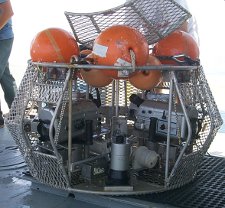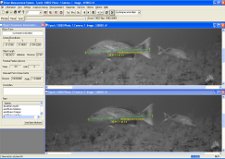Reef Fish Surveys
Objective: To provide an index of the relative abundances of fish species associated with topographic features (banks, ledges) located on the continental shelf of the Gulf of Mexico in the area from Brownsville, Texas to Dry Tortugas, Florida.
- Two yearly surveys are conducted to determine an index of relative abundance of Reef Fish.
- SEAMAP Reef Fish Survey of offshore banks.
- Madison-Swanson and Steamboat Lumps Marine Protected Areas
- A carribean Reef Fish survey is conducted in three year cycles.
- Designed to determine a relative abundance of Reef fish on the shelf of Puerto Rico and the US Virgin Islands.
- Sampling is conducted using video camera arrays, fish traps and vertical longlines.
- Videos are randomly selected for review to determine estimates of abundance.
- Fish traps are used to assess age, fecundity and growth studies.
- Camera technology has greatly evolved since the origination of these surveys and so have the arrays being deployed as part of these surveys.
SEAMAP Reef Fish Survey station selection
The survey area for the offshore banks is large; therefore a two-stage sampling design is used to minimize travel time between sample stations. The first-stage or primary sampling units (PSUs) are blocks 10 minutes of latitude by 10 minutes of longitude. The first-stage units are selected by stratified random sampling, with stratum boundaries defined by geographic region (4 regions: South Florida, Northeast Gulf, Louisiana-Texas Shelf, and South Texas), and by reef habitat area. There are a total of seven strata. The ultimate sample sites (second stage units) within a block are selected randomly.

Reef Fish Survey Area Map
Credit: SEFSC
Madison-Swanson and Steamboat Lumps

Marine Reserves on the West Florida Shelf
Credit: SEFSC

Chevron Trap
Photo Credit: SEFSC

Stereo Camera Array
Photo Credit: SEFSC
The Madison-Swanson and Steamboat Lumps marine reserves on the West Florida Shelf were established by the Gulf of Mexico Fishery Management Council (GMFMC) in 1999. They were established primarily to protect spawning aggregations of gag grouper, (Mycteroperca microlepis), which are considered to be at risk since this protogynous species is attracted to high-relief sites where they aggregate to spawn. These reserves contain areas of reef structure that support populations of economically valuable reef fish and other reef-associated fishes and invertebrates. The main objectives of the survey are to document the relationship between habitat and species assemblages and track changes in reef fish abundance and distribution over time. The survey is conducted within the boundaries of Madison-Swanson and Steamboat Lumps, and a control area on the west Florida shelf known as the Twin Ridges.
Station Selection
A stratified-random sample design is employed to select sample sites within each MPA. Sites at Twin Ridges are selected randomly. Fish are sampled with the same video camera array and fish trap used for the SEAMAP reef fish survey.
Chevron Fish Trap
Fish traps are currently being used to capture fish for age fecundity and growth studies. The chevron trap is approximately 1.83 m X 1.83 m X 0.75 m with 3.81-cm mesh. The trap is baited with squid and soaks for one hour.
Video Camera Array
The most current stereo camera array adopted in 2008. This array is baited with squid and allowed to soak for 45 minutes.

Video Camera Array parts
Photo Credit: SEFSC
Vertical Long Lines
Introduced in 2010 the vertical long line consists of a 12V bandit reel with 1.6 mm steel braid main line. Attached to the mainline is a backbone consisting of 10 sections each with a 2 foot gangeon. A 5-kg weight is placed at the terminal end of the backbone to insure stability and fishing throughout the water column.
Reviewing Reef Fish Tape
There are 9 readers and 3 reviewers at the lab. A singled camera is viewed for the index. The camera is chosen randomly out of all camera in focus and unobstructed. We attempt to identify all fish to the species level. This is not always possible, especially with fish farther ranges from the camera. The estimator of abundance is minimum count. This is analogous to MAXNO (Maximum Number, the greatest number of individuals in the field of view at one instance).
With the video data, we determined the minimum count recording the time each fish entered and left the field of view. This was very time consuming. We now quickly view the images and record the frame or time stamp of the image when the maximum number of a species is observed along with the number. Other data recorded is the time of first occurrence of a species and the time of last occurrence.

1992-1995: Single funnel fish trap with 8mm video camcorder (1992-1993) in Amphibico housing. Hi-8mm camcorder 1994-1995
Photo Credit: SEFSC

1995: Four-camera array using Hi8-mm video cameras in Amphibico housings
Photo Credit: SEFSC

2001: Five camera pod using 4 Sony VX1000 digital camcorders in Gates housings, and a single, down-looking Sony PC110 or PC120 digital camcorder in a Gates housing
Photo Credit: SEFSC

2008-present: Four-camera stereo array
Photo Credit: SEFSC
Vision Measurement System (VMS)

VMS software screenshot
Photo Credit: SEFSC
Now we are currently using VMS to get length measurements of all FMP species present at the min count. Import the left and right stereo image, select the head and the tail and it gives you a 3D measurement. The primary function of VMS is the photogrammetric network adjustment of 2D measurements to target images on photographs, usually digital images, so that the most probable 3D object space coordinates of the targets can be determined.
For the future
Additional multibeam sonar mapping of the shelf will result in an increase to sampling frame (eg. Horseshoe Reef, Mapping of Pulley Ridge). Addition of a Series Lens Coupled Intensifier for CCD cameras will allow for deeper deployments. Addition of vertical longline gear to collect hard parts (i.e. otoliths, stomachs, gonads) two stations a day.
How Do I...?
- Distinguish a white marlin from a spearfish
- How do I report a stranded/ beached whale, dolphin, or turtle?
- How do I report a lionfish sighting?
- Access SouthEast Data, Assessment, and Review (SEDAR)
- How do I report for my fishing/dealer permit requirements?
- How do I report a retrieved tag?
- How do I find current fishery closures?
- How do I adopt a billfish?
- How do I register my billfish tournament?
- How do I apply for a permit?
- Visit the SEFSC library
- How do I find NOAA staff?
- How do I apply for grant funding?
- How do I request permission to use a photo found on the website?
- How do I find It? Provide Website Feedback



